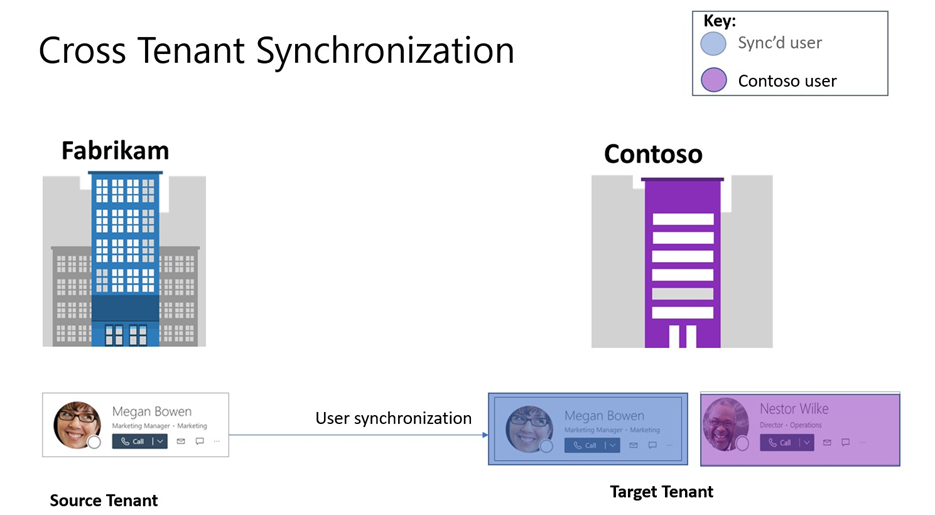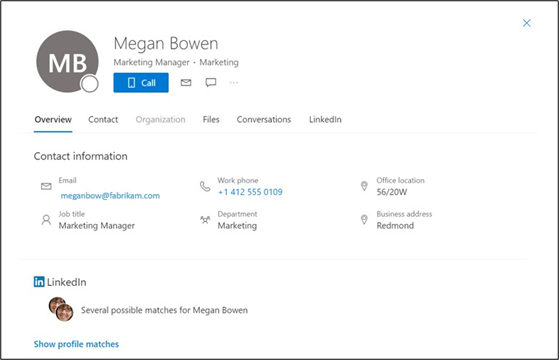Microsoft 365 multitenant Organization People Search
The multitenant Organization (MTO) People Search is a collaboration feature that enables search and discovery of people across multiple tenants. A tenant admin can enable cross-tenant synchronization that allows users to be synced to another tenant and be discoverable in its global address list. Once enabled, users are able to search and discover synced user profiles from the other tenant and view their corresponding people cards.

Fig 1: Microsoft Entra cross tenant synchronization illustration
Example scenario
Megan's user account has been synced from the Fabrikam tenant to the target tenant, Contoso. Nestor from Contoso would like to search and view Megan's people card in Teams. After Megan's account has been synced, Nestor can search and discover Megan's people card in any of the Microsoft 365 apps.

Fig 2: User can view a limited people card
Known limitations
- The Microsoft Teams audio and video call buttons will direct the call to the Megan's Contoso tenant Teams instance and not the Teams instance target tenant (Fabrikam).
- The current experience provides limited information on the people card (basic contact information, job title and office location).
- There's no external tag to differentiate synced users and internal users. For example, if there was a megan@fabrikam and megan@Contoso there's no (External) tag to show that megan@fabrikam is a different user.
- Converting an external guest into an external member or converting an external member into an external guest isn't currently supported by Teams.
Prerequisites
To test the MTO People Search feature, it's assumed that you already have the following settings:
- Two Microsoft Entra / Microsoft 365 tenants
- Both tenants have the Microsoft Entra Cross-tenant Synchronization feature enabled
- Provisioned users from home to target tenants
Use Cases
Multitenant organization people search is supported across a range of scenarios and Microsoft 365 applications. Some of the scenarios you can test and validate are described below:
Microsoft Outlook (OWA, desktop and mobile app)
- Nestor (nestor@contoso.com) searches for "Megan" on the centralized search bar in OWA and gets the results and can view Megan's people card with limited profile information.
- Nestor types in "Megan" in the To line of the email and can send an email to Megan after getting the results for megan@fabrikam.com.
- Nestor @mentions "Megan" in the body of the email and can get the result for megan@fabrikam.com.
- Nestor types in "Megan" in the cc line of the email and can get the result for megan@fabrikam.com.
- Nestor can hover and/or click on Megan's profile picture/initials to view Megan's limited people card.
Microsoft OneDrive/SharePoint
- Nestor (nestor@contoso.com) searches for "Megan" in the centralized search bar on SharePoint and can get the result for megan@fabrikam.com.
- Nestor can hover and/or click on Megan's profile picture/initials to view Megan's limited people card.
- Nestor can share and collaborate on Office documents with Megan.
Bing for Business
- Nestor (nestor@contoso.com) searches for "Megan" on the search bar and can view Megan's limited people card (megan@fabrikam.com).
Key terminology
Home tenant: The tenant you want to search from. The direction of the search is outbound.
Resource tenant: The tenant you want to search in. The direction of the search is inbound.
A tenant can be both home and resource tenant simultaneously.
Cross-Tenant synchronization is a feature that enables multitenant organizations to grant users access to applications in other tenants within the organization. It achieves this by synchronizing internal member users from a home tenant into a resource tenant as external B2B users.
Feedback
Coming soon: Throughout 2024 we will be phasing out GitHub Issues as the feedback mechanism for content and replacing it with a new feedback system. For more information see: https://aka.ms/ContentUserFeedback.
Submit and view feedback for